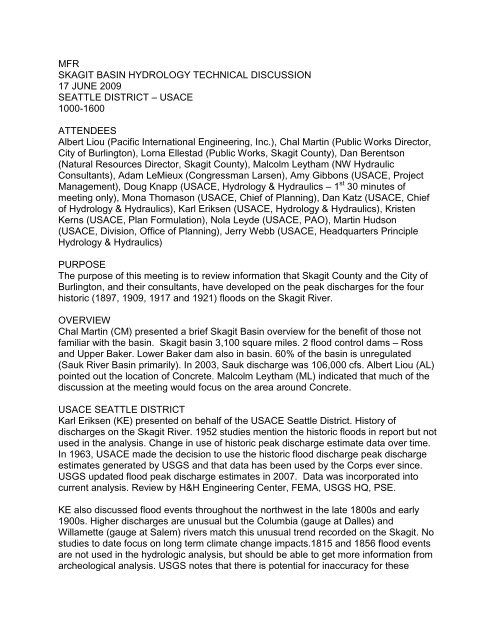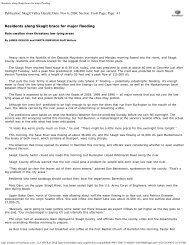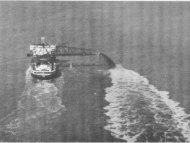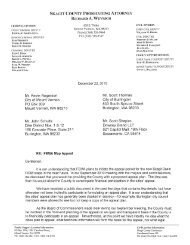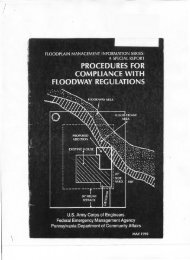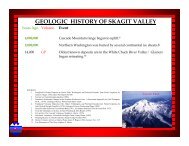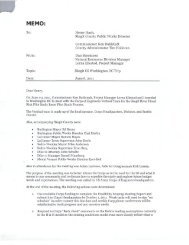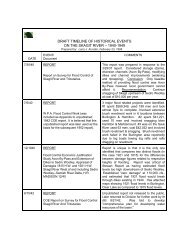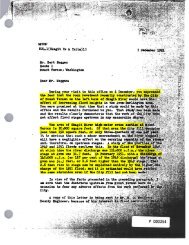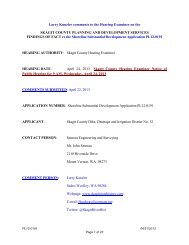attendees - Skagit River History
attendees - Skagit River History
attendees - Skagit River History
You also want an ePaper? Increase the reach of your titles
YUMPU automatically turns print PDFs into web optimized ePapers that Google loves.
MFR<br />
SKAGIT BASIN HYDROLOGY TECHNICAL DISCUSSION<br />
17 JUNE 2009<br />
SEATTLE DISTRICT – USACE<br />
1000-1600<br />
ATTENDEES<br />
Albert Liou (Pacific International Engineering, Inc.), Chal Martin (Public Works Director,<br />
City of Burlington), Lorna Ellestad (Public Works, <strong>Skagit</strong> County), Dan Berentson<br />
(Natural Resources Director, <strong>Skagit</strong> County), Malcolm Leytham (NW Hydraulic<br />
Consultants), Adam LeMieux (Congressman Larsen), Amy Gibbons (USACE, Project<br />
Management), Doug Knapp (USACE, Hydrology & Hydraulics – 1 st 30 minutes of<br />
meeting only), Mona Thomason (USACE, Chief of Planning), Dan Katz (USACE, Chief<br />
of Hydrology & Hydraulics), Karl Eriksen (USACE, Hydrology & Hydraulics), Kristen<br />
Kerns (USACE, Plan Formulation), Nola Leyde (USACE, PAO), Martin Hudson<br />
(USACE, Division, Office of Planning), Jerry Webb (USACE, Headquarters Principle<br />
Hydrology & Hydraulics)<br />
PURPOSE<br />
The purpose of this meeting is to review information that <strong>Skagit</strong> County and the City of<br />
Burlington, and their consultants, have developed on the peak discharges for the four<br />
historic (1897, 1909, 1917 and 1921) floods on the <strong>Skagit</strong> <strong>River</strong>.<br />
OVERVIEW<br />
Chal Martin (CM) presented a brief <strong>Skagit</strong> Basin overview for the benefit of those not<br />
familiar with the basin. <strong>Skagit</strong> basin 3,100 square miles. 2 flood control dams – Ross<br />
and Upper Baker. Lower Baker dam also in basin. 60% of the basin is unregulated<br />
(Sauk <strong>River</strong> Basin primarily). In 2003, Sauk discharge was 106,000 cfs. Albert Liou (AL)<br />
pointed out the location of Concrete. Malcolm Leytham (ML) indicated that much of the<br />
discussion at the meeting would focus on the area around Concrete.<br />
USACE SEATTLE DISTRICT<br />
Karl Eriksen (KE) presented on behalf of the USACE Seattle District. <strong>History</strong> of<br />
discharges on the <strong>Skagit</strong> <strong>River</strong>. 1952 studies mention the historic floods in report but not<br />
used in the analysis. Change in use of historic peak discharge estimate data over time.<br />
In 1963, USACE made the decision to use the historic flood discharge peak discharge<br />
estimates generated by USGS and that data has been used by the Corps ever since.<br />
USGS updated flood peak discharge estimates in 2007. Data was incorporated into<br />
current analysis. Review by H&H Engineering Center, FEMA, USGS HQ, PSE.<br />
KE also discussed flood events throughout the northwest in the late 1800s and early<br />
1900s. Higher discharges are unusual but the Columbia (gauge at Dalles) and<br />
Willamette (gauge at Salem) rivers match this unusual trend recorded on the <strong>Skagit</strong>. No<br />
studies to date focus on long term climate change impacts.1815 and 1856 flood events<br />
are not used in the hydrologic analysis, but should be able to get more information from<br />
archeological analysis. USGS notes that there is potential for inaccuracy for these
floods. Data from USGS is accepted by the Corps without corps reproducing the same<br />
data.<br />
CM questioned whether a mix of gauged data and discharge estimates on the Columbia<br />
and Willamette <strong>River</strong>s in different years from the <strong>Skagit</strong> events could be correlated in<br />
any way to the <strong>Skagit</strong> historic events. ML also noted the Columbia events were spring<br />
floods. ML stated that doesn’t indicate magnitude and KE agreed.<br />
CM stated with regard to the 1856 and 1815 flood events, it has been suggested that<br />
more could be learned through paleo-studies. He noted that in his experience studying<br />
the more recent floods of 1897 forward, he has seen that the fog of time makes trying to<br />
reconstruct events of more than 100 years ago, very difficult. He believes the more<br />
recent floods around the turn of the last century are as far back as we can reasonably<br />
go. He indicated that the older <strong>Skagit</strong> data (1815 and 1856) is too uncertain and<br />
shouldn’t be used on the slide being shown to infer any correlation with other large flood<br />
events in the Columbia <strong>River</strong> and Willamette <strong>River</strong> basins.<br />
ML stated that he would like more specificity on the type of review conducted by the<br />
Corps for the historic floods in question. KE responded that USGS looked at Stewart in<br />
the 1950’s. In 2004 and 2007 USGS did two more confirmation studies. Best estimates<br />
have been established, but not without question.<br />
ML asked what has the Corps done? Is it relying on USGS? KE responded yes.<br />
AL stated that Stewart’s estimated historical flood discharges had been known since<br />
1923. In 1954 the Corps questioned Stewart’s estimates and concluded the estimates<br />
should not be used. Given that 1954 conclusion, and notwithstanding the publication of<br />
WSP 1527, what is the specific logic trail that caused the Corps to change its mind and<br />
use the USGS data now? KE responded that there is no dialog or text defining the<br />
Corps reasoning. Once USGS publishes data, USACE accepts it. The decision since<br />
the 1970s has been to include the historic flood data and that decision has been<br />
maintained since then.<br />
CITY BURLINGTON – PUBLIC WORKS<br />
Chal Martin (CM) presented on behalf of the City of Burlington. County hired Pacific<br />
International Engineering (PIE) to supplement GI efforts in 2002. NW Hydraulic<br />
Consultants (NHC) brought on in 2006 by the County. Burlington and others continued<br />
to work with PIE. A consortium of Mount Vernon, Burlington, Dike District 1 and Dike<br />
District 12 brought PIE on in early 2007. Dalles bridge gauge installed in 1924 and has<br />
provided good readings for USGS. Good data from 1924 to present. USGS has revised<br />
historic floods downward slightly. Forensic evidence of houses was incorporated into<br />
hydraulic modeling by PIE – first in Hamilton, then Concrete in accordance with<br />
Stewart’s documented survey notes. Stewart, RR, and 1995 and 2003 high water marks<br />
were collected and incorporated into modeling. Extensive information collected for<br />
Hamilton area on Smith house and cigar store. Smith house (built in 1908) has survived<br />
multiple floods. House is not tied down to foundation. Flood of 95 lifted the house
slightly and repairs made after that. Forensic evidence of Smith house interior walls<br />
shows no evidence of silt marks. Exterior walls have significant markings. Based on this<br />
evidence, hydraulic analysis indicated maximum discharge since 1908 would be<br />
188,000 cfs. Based on Stewart’s survey work in Hamilton, floods appeared to be<br />
smaller. The Hamilton work led to additional forensic and hydraulic modeling study of<br />
the Crofoot’s Addition to Concrete. Old Wolfe residence in Crofoot (Concrete) is<br />
approximate location of additional Stewart’s high water mark in Concrete, which Stewart<br />
surveyed twice in 1922. Jenkins house at 7752 South Dillard in Concrete, gives good<br />
high water mark for 2003 flood event. Forensic studies at the Jenkins and Ripple<br />
houses indicated previous flooding was likely not much above first floor level of the<br />
Crofoot’s houses, consistent with the results obtained from extending the hydraulic<br />
model upstream from the known stage/discharge information from the Dalles gauge, at<br />
the Crofoot’s Addition. Jenkins house photo provided valuable information for accurately<br />
calibrating the HEC-RAS hydraulic model because of the clear high water mark for the<br />
2003 flood event, and the time indication on the picture. The hydraulic model, based on<br />
discharges for the 2003 flood event, starts with the known stage/discharge information<br />
at the Dalles gauge, and extends the stage/discharge curve upstream to the Crofoot’s<br />
Addition based on substantive and plentiful information from a variety of sources.<br />
Consortium of Burlington, Mount Vernon, Dike District 1 and Dike District 12 believe the<br />
1921 peak discharge was 169,700 cfs at Concrete.<br />
SKAGIT COUNTY – NORTHWEST HYDRAULIC CONSULTANTS (NHC)<br />
Malcolm Leytham (ML) presented on behalf of <strong>Skagit</strong> County. Work by NHC has been<br />
mostly independent of work by PIE, but has shared information regarding forensic<br />
investigations and interpretation of Stewart’s work. No one has investigated or<br />
considered reliability of 1921 high water marks. There has not been an assessment of<br />
the full body of information. Lack of attention to historic high water marks. Reliable slope<br />
area measurements require good high water marks. There are unexplained<br />
inconsistencies between the field notes and the slope area measurements calculated by<br />
the USGS. Tremendous difficulty in identifying in field high water marks after the fact.<br />
Should not accept 1921 water marks as unquestioned values. Estimation of the 1921<br />
high water marks between Dalles and Concrete comes from the Concrete Herald and<br />
Stewart’s work from 1923. This was then incorporated into HEC-RAS. Un-reconciled<br />
discrepancy of gauge reading for high water mark at the upper Dalles gauge. Modeling<br />
in the Dalles is complex 3-D flow conditions, no reliable data on head loss through the<br />
Dalles. NHC’s approach was to brackets the range of hydraulic conditions by using two<br />
alternate model runs, within the low and high value range, for the head loss through the<br />
Dalles. We know stage elevation at the Dalles and Crofoot during 2003 flood event. So<br />
when you calibrate the model you have to make the elevations match. What difference<br />
does it make-the expansion and roughness coefficient-when you are trying to figure out<br />
1921 discharge? –Velocity and head loss through the Dalles are affected. Rating data<br />
show February 1932 and October 2003 overlay. The current 228,000 for Dec 1921 peak<br />
is too high and is inconsistent with the available high water date at Concrete.<br />
CM asked what difference do these coefficients make? ML responded that they impact<br />
discharge going into the Crofoot Addition. (CM note after meeting: it should be
emphasized that this minor uncertainty does not substantively impact the<br />
stage/discharge results provided by the hydraulic model for the Crofoot’s location at<br />
Concrete). The primary sources of uncertainty in the published slope-area estimate is<br />
the high water data derived from field survey. USACE does not have a recognized<br />
technique for incorporating measurement uncertainty in modeling.<br />
Amy Gibbons (AG) asked if this data was presented to USGS. CM answered that it was<br />
presented to USGS. USGS was surprised by large discrepancy in results but is sticking<br />
to their 2007 report because USGS cannot use outside data. The official USGS position<br />
is that they were staying with the existing publication.<br />
IDENTIFICATION AND DISCUSSION OF ISSUES<br />
It was stated that Burlington wants to find best estimates. <strong>Skagit</strong> County doesn’t want to<br />
be biased toward conservatism.<br />
Best estimate vs. Conservatism<br />
Jerry Webb (JW) stated that from a USACE standpoint, we need to recognize that there<br />
are different means of developing and analyzing data.<br />
AG stated for the GI this is not an academic exercise and we are concerned with<br />
producing products. The next step is the FSM which serves as upward reporting and<br />
establishes without project conditions.<br />
CM stated the ‘what if’ issue always gets wrapped around historic flows. The issue is<br />
not what happens after we utilize the flows but rather what the values should be.<br />
One of the issues has always been that the USACE has the mechanism to address<br />
uncertainty and risk in HEC-FDA. Need to come up with the best defensible data and<br />
agree on a resolution.<br />
JW/Martin Hudson (MH) stated that the regulations that governs USACE requires risk<br />
assessment over full range of project loading conditions. Sponsors are indicating there<br />
is a fairly significant uncertainty for extreme loads. In reality what USACE does is<br />
incorporate risk analysis into the entire full range of conditions. USACE cannot get by<br />
with the simplicity of this statement because a full range of risk is evaluated and<br />
accounted for in the risk assessment. The USGS, Weather Service, and USACE are all<br />
governed under multiple federal regulations and must utilize common data to the extent<br />
practicable. USGS is responsible for historical flows and since these discharges are<br />
published as official data significant and compelling reasoning will be required to justify<br />
changes in the data for use in the GI. This is analogous to the Weather Service being<br />
responsible for official river forecasts. USACE must recognize USGS as the official<br />
record. When it comes to public safety, when in doubt, must be conservative as part of<br />
a public service organization. USGS uses a totally different methodology when<br />
evaluating historic flows that have been verified twice. USGS published data is very<br />
difficult to counter and calibration is outside of scope of USACE methodology. USACE
Office of Counsel had provided the guidance that while USACE may generate data,<br />
USGS is the official data of record and USACE will not conflict that record unless there<br />
is compelling reasons to do so.<br />
JW stated in a post-Katrina environment, when in doubt, USACE will proceed with<br />
caution when it comes to public safety. MH stated that this is incorporated into USACE<br />
methods as the Nation Economic Development plan will address what happens when<br />
design levels are exceeded. The GI will discuss with the Planning Excellence Center on<br />
how the risk analysis will be conducted.<br />
JW stated that, while the information presented is interesting, he does not think it meets<br />
the level of compelling enough to change the methodologies used by the GI.<br />
Sponsor and Burlington argue that their information has enough scientific validity to<br />
warrant a reevaluation of USGS information. KE responded that the participants<br />
presentations were scientific but that their information has strengths and weaknesses.<br />
Using other than USGS data needs to be for compelling reasons.<br />
ML asked if the appropriate venue was USGS. JW stated that we have to consult with<br />
USGS. JW asks if USGS has seen this data. JW stated that USGS needs to maintain<br />
quality and consistency.<br />
JW stated that this is the first time he has had a local government argue for a lower<br />
standard of protection. ML asked how you reflect that bias in the analysis. JW<br />
responded that he doesn’t think of it as bias. USACE’s risk assessment is quantified<br />
within a band. MH stated that USACE used to incorporate this risk into the design via<br />
freeboard.<br />
ML asked if you are incorporating a conservative design on top of conservative data?<br />
JW responded that USACE doesn’t incorporate freeboard anymore because of the use<br />
of incorporating uncertainty in risk bands. ML states the data is biased but USACE<br />
considers the data to be the official data of record.<br />
CM objected to JW’s statement that by insisting the hydrology be corrected, the<br />
consortium of local governments was arguing for increased risk. He stated that incorrect<br />
hydrology would drive larger and higher levee structures through the GI process and<br />
that from Burlington’s perspective; the larger structures posed more risk of catastrophic<br />
failure than lower structures designed for overtopping. Burlington wants overtopping so<br />
everyone gets wet provided there is ample time to move people and animals out of<br />
harms way. 100-year protection for Burlington, as likely defined by a Corps project<br />
based on overstated hydrology, increases the risk downstream.<br />
NHC presentation asks: does USACE have independent authority to decide what data<br />
to use? JW responded that USACE does have flexibility/authority in ungaged basins but<br />
is more limited when official gage sites are available. . USACE has a sister agency<br />
whose primary responsibility is to establish discharges and provide official publications
of records. USACE doesn’t have liberty to just decide to use different data without<br />
compelling evidence. CM stated we have significant and compelling data. How high is<br />
the bar? The studies are independent and present a large body of data.<br />
LE asked if KE can itemize his issues with the reports presented? AG responded that<br />
KE can move forward with putting together a list of issues with the studies presented.<br />
CM stated we need to settle this issue and that the studies provided by the County and<br />
the Cities/Dike Districts are significant and compelling.<br />
JW stated that USGS needs to be involved in further discussions. He indicated that this<br />
shouldn’t uphold progress of the feasibility study. How this data would impact the study<br />
is unknown but to not use the USGS data opens the GI up to challenge.<br />
AL stated that the USGS-published 1921 flood stage elevation at the Dalles gage has<br />
no scientific support (the USGS looked for, but could not find, any evidence to support<br />
the published elevation), and noted that given his substantial first-hand analysis of the<br />
hydrology issue, it is his responsibility as a Professional Engineer to develop the best<br />
engineering report based on his professional engineering judgment.<br />
MH stated that there is no USACE policy with regard to a local agency disagreeing with<br />
USGS published data that stops the GI from moving forward.<br />
JW stated that if the H&H does change, the model can be rerun to incorporate the<br />
changes and make adjustments. He stated that he doesn’t see compelling evidence to<br />
go against standards.<br />
TASKS<br />
KE will provide a list of concerns relating to the studies presented for delivery to<br />
Burlington and the Sponsor no later than the last day of July 2009 (preferably sooner).<br />
AG stated the project will move forward. LE stated we need to get a handle on water<br />
discharged into the system and that the GI needs to be cognizant of how changes will<br />
impact the project. (LE note after the meeting: One of the major concerns was the ability<br />
to accurately evaluate the environmental impact of proposed measures. The concern<br />
wasn’t just on the 100 year discharge but the impact to the full range of the hydrograph<br />
i.e. the increased discharge associated with more frequent 25 to 50 year events.<br />
MH/JW responded that based on their experience, USACE process will address LEs<br />
concerns.<br />
Mona Thomason stated that USACE can develop a sensitivity analysis plan to test the<br />
outcome sensitivity to discharges of 195,000 cfs vs 228,000 cfs. CM stated the<br />
sensitivity analysis should not be limited to 195,000 cfs, noting that NHC internally<br />
documented its conservative approach and pointing out that the Cities/Dike Districts<br />
have concluded a 1921 peak discharge of 169,700 cfs is the best estimate.
USACE will not adopt the new data at this time. USACE will participate in meeting with<br />
Burlington, the Sponsor and USGS to discuss the data but the ultimate decision will be<br />
up to USGS.<br />
Corps will commit to the end of July to provide H&H status update.


